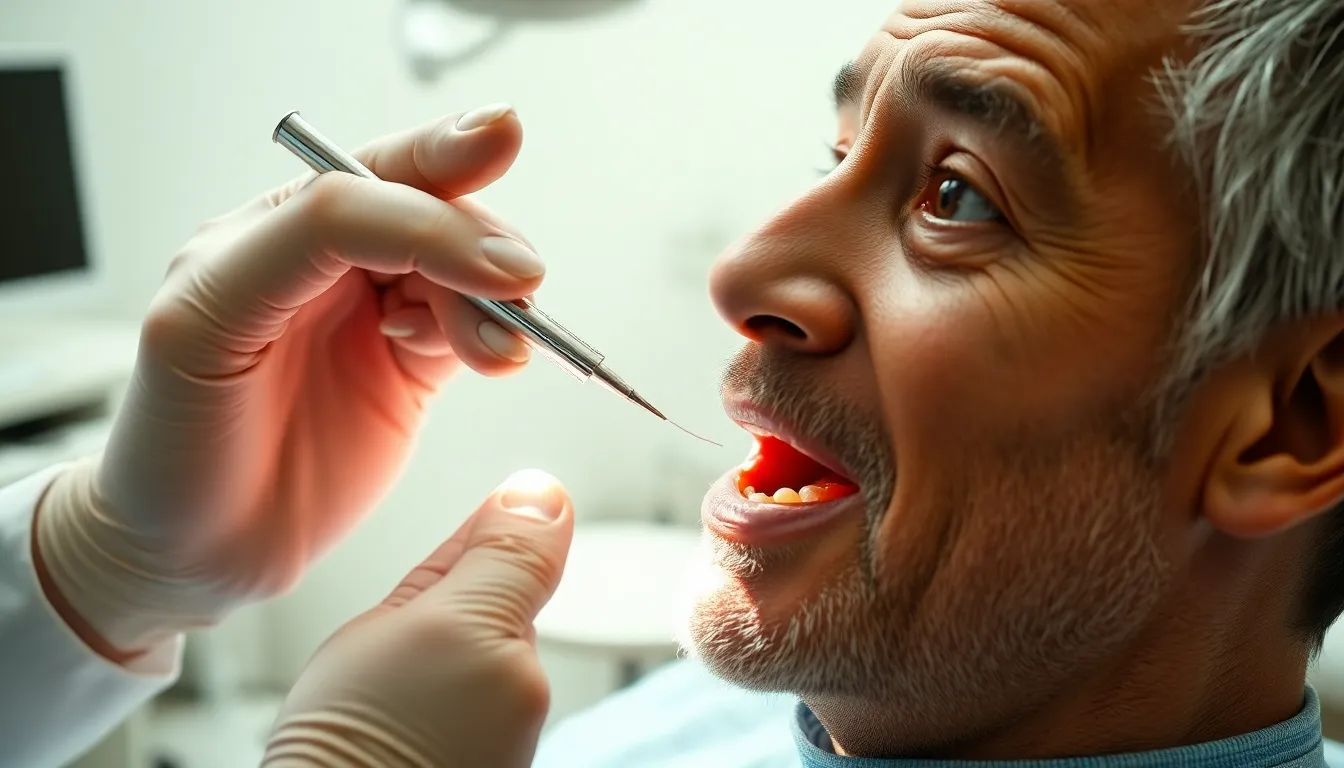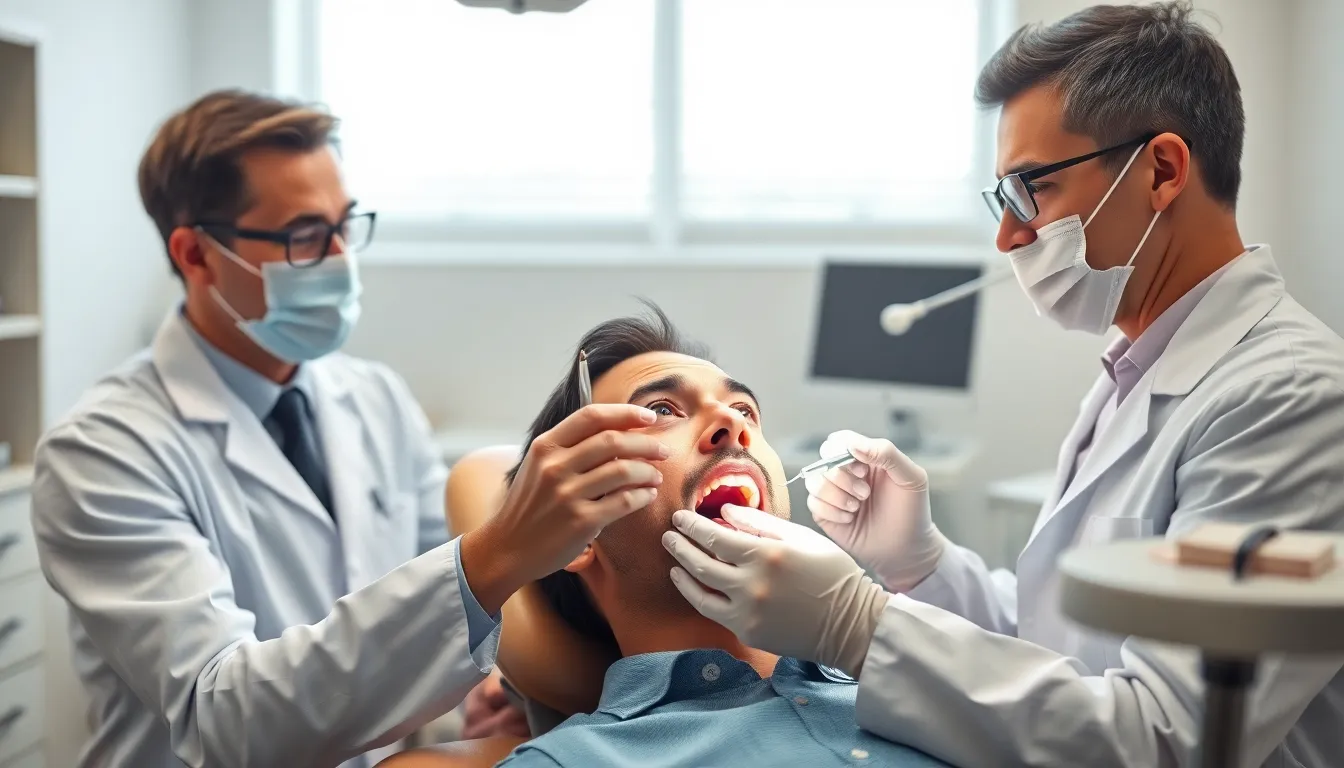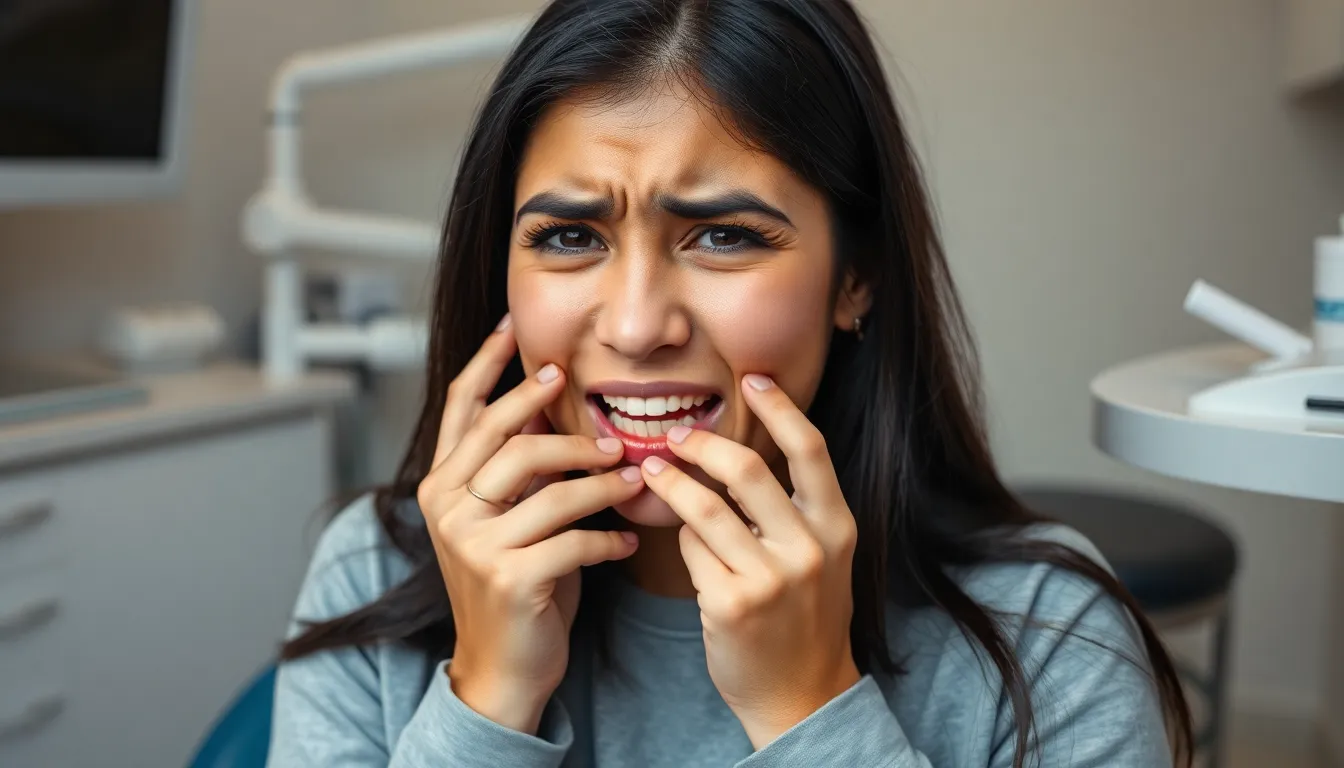Looking for gum graft alternatives that won’t expensive or require painful surgery? You’re not alone. Millions of Americans struggle with gum recession each year, seeking less invasive options to traditional grafting procedures.
Fortunately, modern dentistry has evolved, offering several effective alternatives to conventional gum grafts. From pinhole surgical techniques to platelet-rich fibrin treatments, these innovative approaches can provide similar results with reduced recovery time and discomfort. Whether you’re dealing with mild recession or trying to avoid extensive periodontal surgery, understanding your options is the first step toward restoring your gum health and protecting your smile for years to come.
What Are Gum Grafts and Why Are They Used?
Gum grafts are surgical procedures that involve taking tissue from one area of your mouth and attaching it to areas where your gums have receded. Dentists typically harvest this tissue from the roof of your mouth (palate) or nearby gum tissue. Traditional gum grafting addresses recession by covering exposed tooth roots with the transplanted tissue.
Many patients come to our practice concerned about gum recession, like Sarah who noticed her teeth appearing longer and experiencing sensitivity to hot and cold foods. Dr. Harris explains that gum grafts serve several important purposes beyond cosmetic improvement:
- Root protection: Grafts cover exposed roots, reducing sensitivity and preventing further damage
- Decay prevention: Grafted tissue shields vulnerable root surfaces from cavity-causing bacteria
- Gum stabilization: The procedure halts progressive gum recession that can lead to tooth loss
- Cosmetic enhancement: Grafts restore a more balanced, natural-looking smile
Gum recession affects approximately 50% of adults aged 30 and older, according to the CDC. The condition exposes tooth roots, making them vulnerable to decay and sensitivity while creating an aged appearance to your smile. Traditional grafting has been the standard treatment for decades, with success rates exceeding 85% when performed by experienced periodontists.
Common Challenges and Concerns With Traditional Gum Grafts
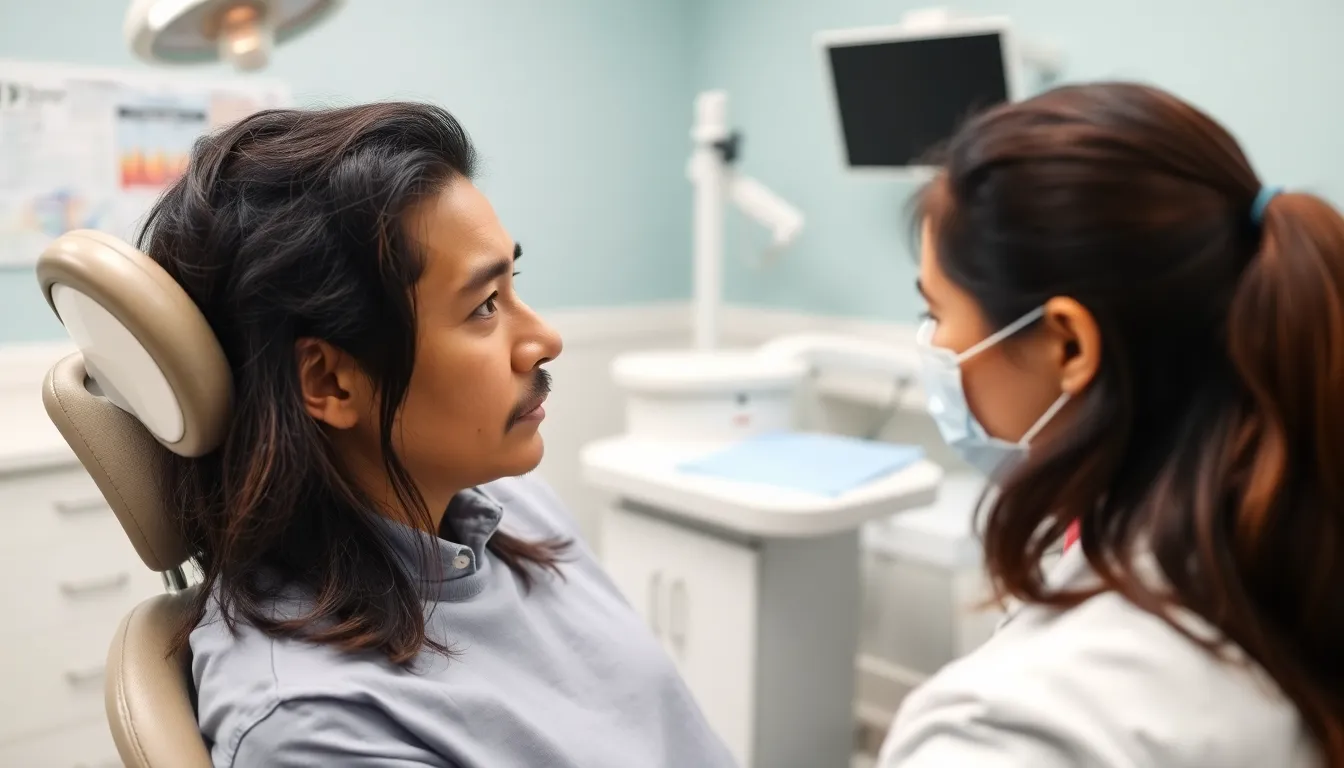
Traditional gum grafting, while effective for treating recession, comes with several important drawbacks that prompt many patients to seek alternatives. The invasive nature of these procedures involves harvesting tissue from the palate or using donor/synthetic materials to cover exposed roots, often resulting in considerable discomfort during and after surgery.
Recovery from traditional grafts typically extends for weeks, requiring meticulous post-operative care and limiting normal activities. Many patients report pain at both the treatment site and the donor area where tissue was removed.
“Last month, I consulted with a patient who had been putting off treatment for years due to fears about traditional grafting,” shares Dr. Todd B. Harris. “After explaining the discomfort and extended recovery time associated with conventional techniques, I could see the anxiety in her eyes. This reaction is common among those facing gum recession issues.”
Donor site morbidity represents another major concern with traditional approaches. When tissue is harvested from the roof of your mouth, this secondary surgical site often becomes more painful than the graft area itself. Patients frequently experience bleeding, swelling, and sensitivity at the donor site for 1-2 weeks following the procedure.
The invasiveness of conventional grafting also contributes to longer healing periods, with complete recovery taking up to 4-6 weeks in many cases. During this time, dietary restrictions and special oral hygiene protocols must be strictly followed to prevent complications.
These challenges explain why approximately 50% of patients with gum recession hesitate to undergo traditional grafting procedures even though their high success rates. The combination of surgical invasiveness, extended recovery periods, important discomfort, and donor site complications drives many to explore the growing number of alternative treatments now available.
Top Gum Graft Alternatives: Modern Solutions
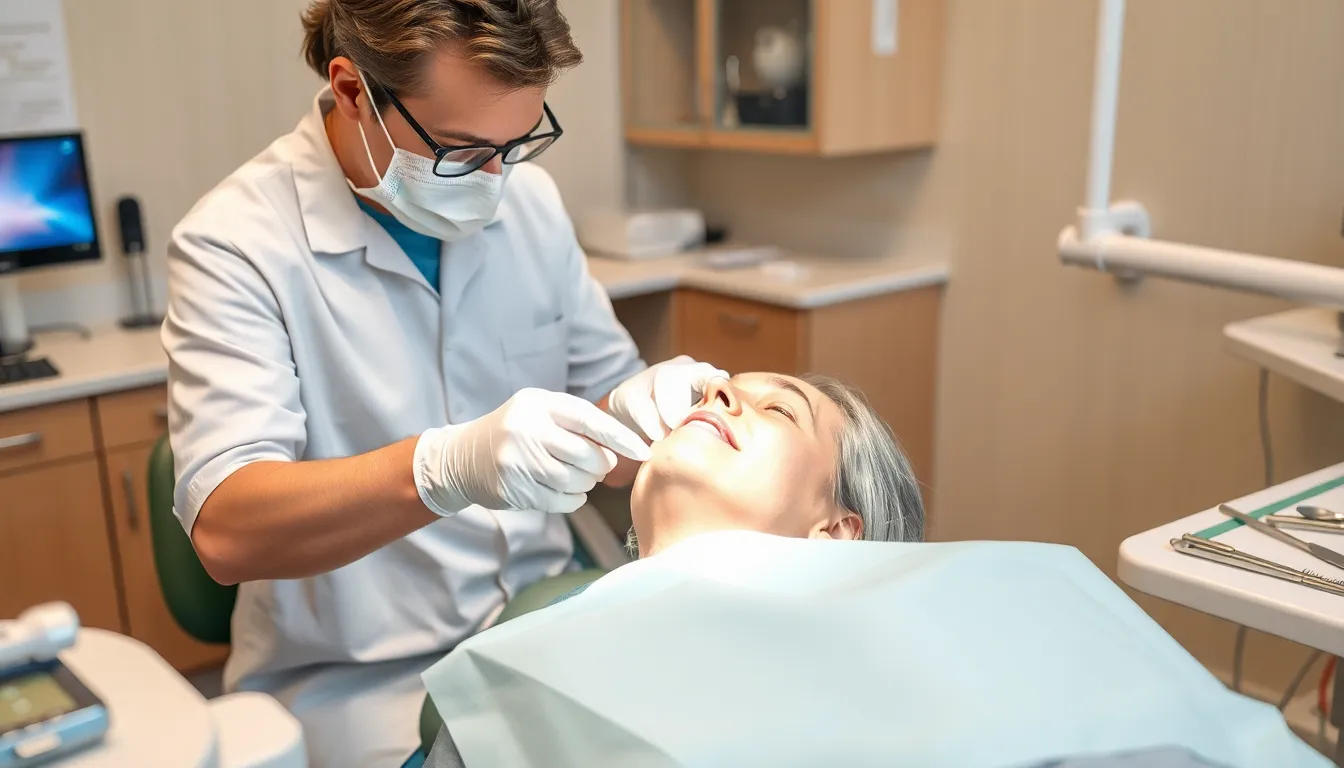
Dental science has evolved significantly, offering patients several effective alternatives to traditional gum grafting procedures. These modern techniques address gum recession with less invasive approaches, reduced recovery time, and comparable results to conventional methods.
Pinhole Surgical Technique (PST)
The Pinhole Surgical Technique revolutionizes gum recession treatment by eliminating the need for grafts, incisions, and sutures. Dr. John Chao developed this minimally invasive procedure where a tiny pinhole is created in the existing gum tissue, through which specialized instruments gently reposition the gum to cover exposed roots. Collagen strips are inserted to stabilize the tissue and promote healing during the procedure. PST offers many advantages including significantly less discomfort, faster recovery times, and natural-looking results without harvesting donor tissue.
Many patients report being able to return to normal activities within 24-48 hours after PST, compared to the weeks of recovery traditional grafting requires. Local anesthesia ensures your comfort throughout the procedure, while the small entry point minimizes trauma to surrounding tissues. Dr. Harris notes, “I’ve seen remarkable satisfaction among patients who choose PST—they’re often surprised by how quick and comfortable the entire process is compared to what they anticipated.”
Platelet-Rich Fibrin (PRF) Therapy
Platelet-Rich Fibrin therapy harnesses your body’s natural healing abilities to regenerate gum tissue. This technique involves drawing a small amount of your blood, processing it to isolate the fibrin-rich components, and applying this concentrated healing material directly to the treatment area. PRF contains growth factors that stimulate tissue regeneration and accelerate healing processes naturally.
The fibrin matrix serves as a scaffold for new tissue development while releasing beneficial proteins for up to 7-10 days after placement. PRF therapy can be used alone for minor recession or combined with other techniques for more extensive cases. Sarah, a recent patient, shared, “After trying PRF therapy for my receding gums, I noticed my sensitivity decreased within days, and my dentist confirmed important tissue regeneration at my follow-up appointment.”
Alloderm Regenerative Tissue Matrix
Alloderm offers an excellent alternative when you need substantial tissue augmentation without harvesting from your palate. This acellular dermal matrix derived from donated human skin tissue functions as a ready-to-use graft substitute. The biocompatible matrix integrates with your existing tissue, promoting cell migration and blood vessel formation to create new, healthy gum tissue.
Surgeons appreciate Alloderm for its versatility in treating multiple recession sites in a single procedure. The material comes in various sizes and thicknesses, allowing customization based on your exact needs. Recovery typically progresses more comfortably than traditional grafting since there’s no second surgical site to heal. Clinical studies demonstrate that Alloderm-treated sites show tissue characteristics nearly identical to natural gums after healing, with success rates comparable to traditional autografts in covering exposed root surfaces.
Minimally Invasive Treatment Options for Gum Recession

Modern dentistry has developed several effective alternatives to traditional gum grafting that offer less invasive approaches for treating gum recession. These treatments minimize discomfort and reduce recovery time while providing comparable results for restoring gum health.
Chao Pinhole Surgical Technique in Detail
The Pinhole Surgical Technique (PST) represents a breakthrough in gum recession treatment that doesn’t require cutting, grafting, or suturing. Dr. John Chao developed this revolutionary procedure that involves creating a tiny hole in the gumline through which specialized instruments gently loosen and reposition existing tissue. Your dentist can cover multiple tooth roots in a single session by carefully stretching your natural gum tissue over the exposed areas. Patients typically experience minimal bleeding, significantly less post-operative pain, and faster healing compared to traditional grafts.
One of our patients, Sarah, had avoided addressing her receding gums for years due to fear of painful grafting procedures. After undergoing PST at our practice, she remarked, “I couldn’t believe I was back to normal activities the next day with barely any discomfort. The difference in my smile is amazing.”
Laser Gum Treatments
Laser-Assisted New Attachment Procedure (LANAP) offers another minimally invasive solution for gum recession. This innovative treatment utilizes specialized dental lasers to remove diseased gum tissue while stimulating natural bone and gum regeneration. LANAP effectively promotes tissue regrowth without surgical incisions, making it an excellent option for patients concerned about pain and recovery time.
The precision of laser technology allows for targeted treatment that preserves healthy tissue while eliminating bacteria and inflammation. Your recovery from LANAP typically progresses much faster than with traditional surgery, with many patients returning to normal activities within 24 hours. Dr. Harris notes, “I’ve seen remarkable improvements in patients who previously avoided treatment due to fear of traditional grafting. The laser approach not only addresses recession but can actually trigger the body’s natural healing response to regenerate tissue.”
Complementary treatments such as composite resin application can provide additional protection for exposed roots when used alongside these minimally invasive procedures. Patients with early-stage recession might also benefit from improved home care routines, including gentle brushing techniques and antimicrobial rinses that reduce inflammation and help preserve existing gum tissue.
Natural and Preventative Approaches to Gum Health
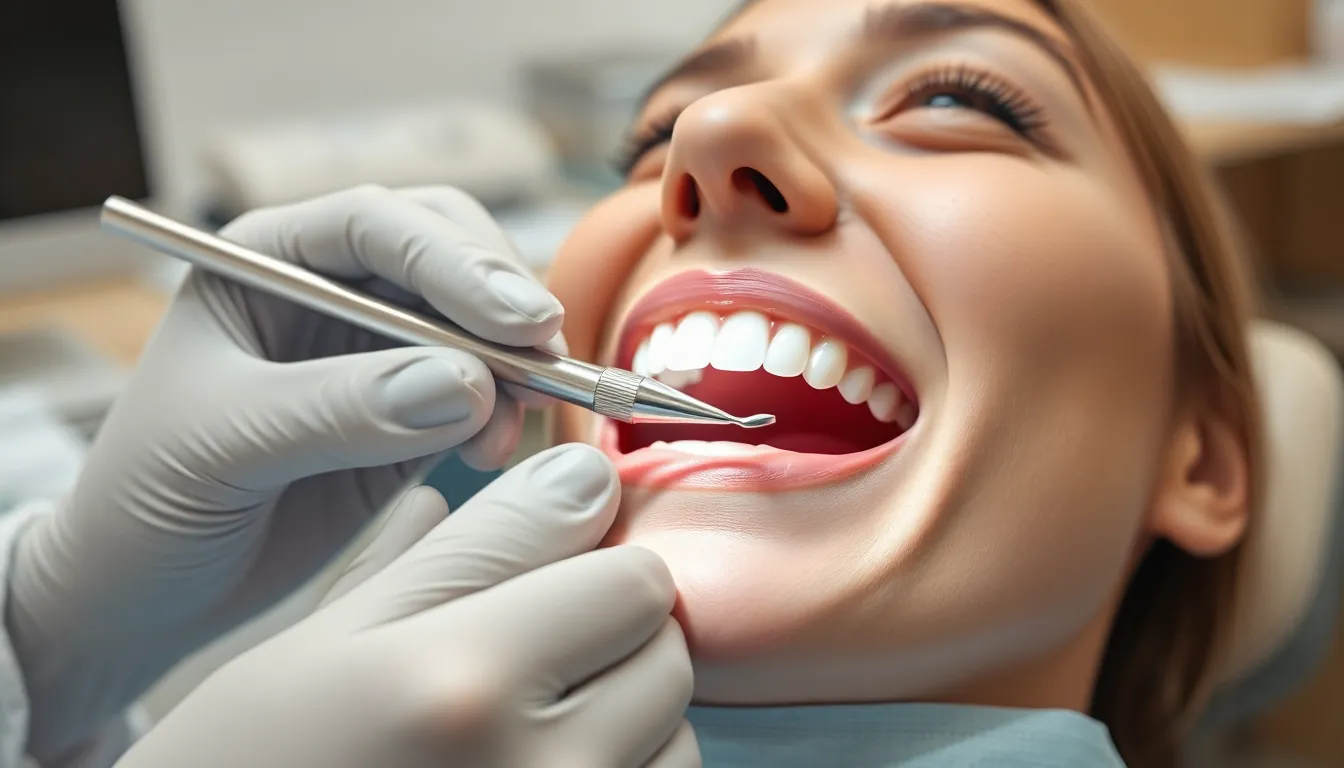
Gum health can often be maintained or improved through non-surgical interventions that address early recession. These preventative approaches serve as the first line of defense against progressive gum disease and may eliminate the need for more invasive procedures.
Scaling and Root Planing
Scaling and root planing functions as a deep cleaning procedure that targets the earliest stages of gum recession. This thorough cleaning removes plaque and tartar deposits both above and below the gumline, eliminating harmful bacteria that contribute to periodontal disease. The procedure creates a clean environment that encourages your gums to reattach to teeth naturally, potentially halting further recession.
Dr. Todd B. Harris notes, “Many of my patients are surprised by how effective scaling and root planing can be for early recession cases. I recently treated a patient named Michael who was concerned about his receding gums but wanted to avoid surgery. After two sessions of deep cleaning, his gums stabilized, and we’ve been able to maintain his oral health with regular maintenance visits.”
Antimicrobial treatments complement mechanical cleaning by reducing bacterial populations in the mouth. These treatments include prescription-strength mouthwashes containing chlorhexidine or other antibacterial agents that target periodontal pathogens. Regular use of these products alongside professional cleanings creates an environment where gums can heal naturally.
Gum contouring offers another approach for addressing minor recession while improving aesthetic concerns. This procedure reshapes irregular gum lines to create a more balanced appearance. For patients with minor recession combined with aesthetic concerns, contouring sometimes provides sufficient improvement without needing tissue grafts.
Specialized Oral Hygiene Protocols
LANAP (Laser Assisted New Attachment Procedure) represents a breakthrough in minimally invasive gum treatment. This FDA-approved laser protocol selectively removes infected gum tissue while preserving healthy tissue. The laser stimulates bone regeneration and promotes gum reattachment to tooth surfaces with significantly less discomfort than traditional surgical methods.
“The transformation I’ve seen in patients who undergo LANAP is remarkable,” shares Dr. Harris. “The recovery time is dramatically reduced—most patients return to normal activities within 24 hours compared to weeks with traditional surgery.”
Flap surgery combined with regenerative techniques offers another alternative for moderate to severe recession cases. Modern approaches incorporate stem cell technology, such as the RejuvaGum Lift™, which stimulates your body’s natural healing mechanisms. This procedure encourages gum tissue regeneration without harvesting tissue from other sites in your mouth, resulting in less pain, faster recovery, and natural-looking results.
Nutritional Support for Gum Regeneration
Proper nutrition plays a crucial role in maintaining and regenerating healthy gum tissue. Vitamin C stands out as particularly important for gum health because it supports collagen production—the protein that provides structure to your gums. Foods rich in vitamin C include citrus fruits, strawberries, bell peppers, and broccoli.
Antioxidants found in colorful fruits and vegetables help combat inflammation and oxidative stress that can damage gum tissue. Berries, leafy greens, and nuts contain compounds that support tissue repair and protect against cellular damage.
Omega-3 fatty acids possess powerful anti-inflammatory properties that benefit gum health. Regular consumption of fatty fish like salmon, mackerel, and sardines can help reduce gum inflammation and support healing processes. For vegetarians, flaxseeds, chia seeds, and walnuts provide plant-based sources of these beneficial fats.
“I’ve witnessed remarkable improvements in patients who combine clinical treatments with nutritional changes,” Dr. Harris explains. “One patient, Jennifer, was scheduled for multiple gum grafts, but after implementing a comprehensive nutrition plan alongside scaling and root planing, we were able to reduce the number of sites requiring grafting by half. Her body’s natural healing capacity improved dramatically once she optimized her diet.”
Adequate hydration supports gum health by maintaining saliva production, which contains proteins and minerals that protect and repair tissues. Drinking water throughout the day helps wash away food particles and bacteria while supporting overall oral health.
How to Choose the Right Gum Recession Treatment for You

Selecting the optimal treatment for your gum recession depends on several key factors that periodontists consider when creating personalized treatment plans. The severity of your gum recession plays a crucial role in determining which approach will be most effective for your exact situation.
Assess Your Gum Recession Severity
Mild recession (1-2mm) often responds well to non-surgical approaches like scaling and root planing. Moderate recession (3-4mm) might benefit from minimally invasive techniques such as the Pinhole Surgical Technique. Severe recession (5mm or more) with important bone loss may require more comprehensive treatments including bone regeneration procedures.
Dr. Todd B. Harris notes, “I’ve seen many patients delay treatment because they fear traditional grafting, only to discover that their mild recession could have been addressed with simple, painless interventions had they sought care earlier.”
Consider Your Oral Health Status
The presence of active gum disease significantly impacts your treatment options. Underlying infections must be resolved before pursuing any gum recession treatment. LANAP offers a dual benefit for patients with both gum disease and recession by eliminating infection while promoting tissue regeneration.
Evaluate Recovery Time Preferences
Your personal schedule and tolerance for downtime should influence your treatment choice. Traditional grafts typically require 1-2 weeks of restricted activity, while PST patients often resume normal activities within 24-48 hours. Composite resin applications require virtually no recovery time but offer more limited benefits.
“I recommended the Pinhole technique to Michael, a busy executive who couldn’t afford two weeks away from important meetings,” shares Dr. Harris. “He was back presenting to clients just three days after his procedure with minimal discomfort and no visible signs of having undergone treatment.”
Weigh Long-Term Goals vs. Immediate Results
Some treatments provide immediate aesthetic improvements but may need to be repeated. Others offer lasting answers that require more initial investment of time and resources. Stem cell approaches like RejuvaGum Lift™ show promising long-term results by actually regenerating natural tissue rather than simply covering exposed roots.
Compare Treatment Costs and Coverage
Treatment costs vary significantly between options:
| Treatment | Average Cost Range | Insurance Coverage |
|---|---|---|
| Traditional Gum Graft | $700-$1,200 per tooth | Often partially covered |
| Pinhole Surgical Technique | $2,500-$4,000 (multiple teeth) | Limited coverage |
| LANAP | $1,000-$4,000 per quadrant | Varies by provider |
| Scaling and Root Planing | $200-$300 per quadrant | Generally covered |
| RejuvaGum Lift™ | $3,000-$6,000 | Limited coverage |
Consider Specialist Availability
Not all treatments are available at every dental practice. Specialized procedures like PST and LANAP require exact training and equipment. Research periodontists in your area who offer these advanced alternatives to ensure you’re getting treatment from an experienced provider.
Cost Comparison: Traditional Grafts vs. Alternative Treatments
Traditional gum grafting procedures typically cost more than modern alternatives due to their invasive nature and extended recovery periods. Conventional grafts involve harvesting tissue from the palate, requiring more extensive surgery which increases costs related to operative time, anesthesia, and post-operative care. Patients often face additional expenses for pain management medications and multiple follow-up appointments during the weeks-long recovery process.
Minimally Invasive Alternatives
The Pinhole Surgical Technique (PST) offers important cost advantages compared to traditional grafting. Treatment costs remain competitive while eliminating the need for donor tissue, reducing surgical time, and minimizing recovery-related expenses. Many patients return to normal activities within 24-48 hours after PST, compared to the 2-3 weeks typically needed after conventional grafting.
“I was shocked at the difference in price between traditional grafting and PST,” shares Michael, a recent patient. “Not only was the procedure itself more affordable, but I didn’t miss any work days recovering, which saved me hundreds in lost wages.”
Alloderm and Biological Alternatives
Soft tissue grafting with Alloderm uses donated human tissue instead of harvesting from your palate. Material costs for Alloderm may be higher than autografts (your own tissue), but total treatment expenses often balance out due to:
- Shorter operative times
- Reduced anesthesia requirements
- Single surgical site instead of two
- Faster healing periods
- Fewer pain management needs
These advantages translate to fewer missed workdays and less disruption to your daily routine, providing indirect cost savings beyond the procedure itself.
Technology-Based Treatments
LANAP and other laser therapies command premium pricing due to the advanced technology involved. The initial treatment costs may exceed traditional grafting in some cases, yet the value proposition includes:
| Treatment Type | Average Cost Range | Recovery Time | Pain Level | Success Rate |
|---|---|---|---|---|
| Traditional Graft | $700-$1,200 per tooth | 2-3 weeks | Moderate to high | 85-95% |
| PST | $500-$950 per tooth | 1-3 days | Minimal to mild | 85-90% |
| Alloderm Grafts | $600-$1,100 per tooth | 1 week | Mild to moderate | 80-90% |
| LANAP | $1,000-$4,000 per quadrant | 24-48 hours | Minimal | 85-90% |
| Emdogain® Therapy | $300-$600 per tooth | 1-2 days | Minimal | 75-85% |
Dr. Todd B. Harris notes, “While the upfront investment in alternatives like PST or LANAP might seem comparable to traditional grafting, my patients consistently report better value perception due to significantly reduced discomfort and minimal life disruption during recovery.”
Insurance Considerations
Dental insurance coverage varies widely for gum recession treatments. Most plans cover a portion of traditional grafting when deemed medically necessary, typically 50-80% after meeting your deductible. Alternative procedures receive similar coverage rates when properly coded as periodontal treatments, though some newer techniques might be classified as “experimental” by certain insurers.
Always verify coverage details with your insurance provider before committing to any treatment plan. Many dental practices offer payment plans or financing options to make these procedures more accessible, regardless of which treatment approach you choose.
Recovery Time and Post-Procedure Care for Alternative Treatments
Recovery periods vary significantly among gum recession treatments, with modern alternatives generally offering faster healing times compared to traditional grafting procedures. Each treatment option comes with exact post-procedure care requirements essential for optimal results and comfort.
Pinhole Surgical Technique Recovery
The Pinhole Surgical Technique typically results in a remarkably quick recovery process. Most patients return to normal activities within 24-48 hours, experiencing minimal discomfort throughout the healing period. Your post-procedure care includes:
- Gentle brushing around the treated area using a soft-bristled toothbrush
- Rinsing with prescribed antimicrobial mouthwash to prevent infection
- Avoiding hard, crunchy, or spicy foods for 1-2 weeks
- Refraining from smoking or using tobacco products during the healing period
Linda, a 45-year-old patient who underwent PST after years of anxiety about traditional grafting, shared: “I was amazed at how quickly I recovered. There was barely any pain, and I was back at work the next day. The minimal downtime made all the difference for me.”
LANAP Recovery Process
LANAP procedures offer significantly reduced recovery time compared to conventional surgery. The absence of incisions and sutures means you’ll experience less post-operative discomfort and bleeding. Your healing process typically involves:
- Mild sensitivity for 2-3 days following the procedure
- Following a soft food diet for approximately one week
- Using prescribed pain relievers if needed (though many patients require minimal pain management)
- Continuing gentle oral hygiene practices while avoiding aggressive brushing
Deep Cleaning and Scaling Recovery
Recovery from scaling and root planing procedures happens relatively quickly, with most patients experiencing only mild gum tenderness for 2-3 days. Your aftercare routine includes:
- Rinsing with warm salt water several times daily to reduce inflammation
- Taking over-the-counter pain relievers if experiencing discomfort
- Maintaining diligent oral hygiene while being gentle around treated areas
- Attending follow-up appointments to monitor healing progress
Regenerative Treatments Aftercare
Bone regeneration procedures and stem cell therapies like RejuvaGum Lift™ require more extensive healing periods due to the ongoing tissue regeneration process. Your recovery typically spans 2-4 weeks with these exact care instructions:
- Strict adherence to a soft food diet for 2-3 weeks
- Regular use of antimicrobial rinses to support healing
- Avoiding physical activity that could increase blood pressure for 7-10 days
- Attending multiple follow-up appointments to monitor regeneration progress
Dr. Todd B. Harris notes: “The post-procedure care period is just as important as the procedure itself. I’ve seen remarkable differences in outcomes between patients who strictly follow aftercare instructions versus those who don’t. Taking those few extra steps during recovery can significantly impact the long-term success of any gum treatment.”
Comparative Recovery Timeline
| Treatment Option | Average Recovery Time | Pain Level | Return to Normal Activities |
|---|---|---|---|
| Pinhole Surgical Technique | 1-3 days | Minimal | 24-48 hours |
| LANAP | 2-5 days | Low to moderate | 2-3 days |
| Scaling and Root Planing | 1-2 days | Minimal | Immediate to 24 hours |
| Stem Cell Regeneration | 2-4 weeks | Moderate | 7-10 days |
| Traditional Gum Grafting | 2-3 weeks | Moderate to high | 14+ days |
Regardless of the treatment option you choose, maintaining excellent oral hygiene practices following your procedure promotes optimal healing and long-term success. Regular dental checkups allow your provider to monitor your gum health and address any concerns before they progress into more important issues.
Conclusion
The journey to healthier gums doesn’t have to include painful surgeries and lengthy recoveries. Modern alternatives like the Pinhole Surgical Technique and LANAP now offer effective answers with significantly less discomfort than traditional grafting.
Your treatment choice should align with your exact needs considering factors like recession severity personal recovery preferences and budget. Remember that preventative care and proper nutrition play crucial roles in maintaining gum health.
By exploring these advanced options you’re taking an important step toward protecting your smile for years to come. Consult with a periodontist to determine which approach best serves your unique oral health situation and lifestyle requirements.
Frequently Asked Questions
What is gum recession and how common is it?
Gum recession occurs when the gum tissue surrounding teeth wears away, exposing more of the tooth root. It affects approximately 50% of adults aged 30 and older in America. This condition can lead to tooth sensitivity, vulnerability to decay, and aesthetic concerns. Gum recession is often caused by aggressive brushing, periodontal disease, genetics, hormonal changes, or tobacco use.
What are the signs I might need treatment for receding gums?
Look for exposed tooth roots, increased sensitivity to hot or cold, teeth appearing longer than normal, visible notches near the gumline, and increased spaces between teeth. You might also notice bleeding when brushing or flossing, persistent bad breath, or a change in how your bite feels. If you experience any of these symptoms, consult with a dental professional for an evaluation.
How does the Pinhole Surgical Technique work?
The Pinhole Surgical Technique (PST) involves creating a tiny hole in the gumline through which special instruments are inserted to gently loosen and reposition existing gum tissue over exposed root surfaces. No grafts, incisions, or sutures are required. The procedure can address multiple teeth in a single session with minimal bleeding and pain, allowing for significantly faster recovery compared to traditional grafting.
What is LANAP and how does it differ from traditional gum surgery?
LANAP (Laser-Assisted New Attachment Procedure) uses dental lasers to selectively remove diseased gum tissue while promoting natural regeneration. Unlike traditional surgery, LANAP requires no cutting or suturing, resulting in minimal discomfort and bleeding. The laser targets only unhealthy tissue, preserving more of your natural gum structure while stimulating healing and reattachment to the tooth surface.
Can I prevent gum recession without surgery?
Yes, you can prevent or minimize gum recession through proper oral hygiene, including gentle brushing with a soft-bristled toothbrush and regular flossing. Regular dental check-ups, scaling and root planing (deep cleaning), treating underlying gum disease, using a nightguard if you grind your teeth, quitting tobacco use, and maintaining a nutrient-rich diet can all help prevent gum recession without surgical intervention.
How long is the recovery from alternative gum treatments compared to traditional grafting?
Recovery from alternative treatments is significantly shorter. After traditional grafting, full recovery may take 2-4 weeks with considerable discomfort. In contrast, Pinhole Surgical Technique patients typically return to normal activities within 24-48 hours with minimal pain. LANAP recovery averages 2-5 days, while scaling and root planing may only require 24 hours of careful eating. Recovery time varies based on treatment extent and individual healing factors.
What role does nutrition play in gum health?
Nutrition plays a crucial role in gum health and regeneration. Vitamin C supports collagen production essential for gum tissue strength. Antioxidants from fruits and vegetables fight inflammation. Omega-3 fatty acids from fish and nuts reduce gum inflammation. Calcium and vitamin D strengthen the underlying bone structure. Adequate hydration maintains saliva production, which contains proteins and minerals that protect and repair gum tissue.
How do I choose between traditional grafting and alternative treatments?
Consider the severity of your recession, overall oral health, recovery time preferences, long-term goals versus immediate results, budget constraints, and specialist availability. Mild recession may respond well to non-surgical approaches, while moderate to severe cases might require more advanced techniques. Consult with a periodontist who can evaluate these factors and recommend personalized treatment options based on your specific situation.
Are alternative gum treatments covered by insurance?
Coverage varies significantly between insurance providers and plans. Many dental insurance plans partially cover treatments deemed medically necessary to address gum recession, but coverage percentages differ. Purely cosmetic procedures typically receive less coverage. Contact your insurance provider to verify coverage details for specific procedures. Many dental offices also offer payment plans or financing options to make these treatments more accessible regardless of insurance coverage.
How effective are alternative treatments compared to traditional grafting?
Alternative treatments show comparable effectiveness to traditional grafting in many cases. Traditional grafting has success rates exceeding 85%, while techniques like PST and LANAP report similar success rates with significantly less discomfort. The effectiveness depends on recession severity, patient compliance with aftercare, and the practitioner’s skill. For moderate recession, alternatives often provide comparable root coverage and stabilization with faster healing and less pain.



